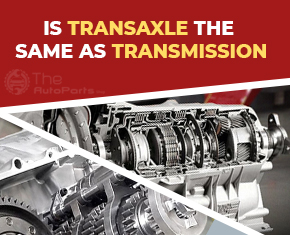This article will discuss the distinctions between a “transaxle” and a “transmission.” In a nutshell, a transaxle combines the gear-changing function of a gearbox with the power-splitting capability of an axle differential. A transmission just changes gears and delivers power through a single output shaft at the back of the machine. Although they both move gears in the same way, there is frequent misunderstanding between these two names since the term “transmission” is occasionally used as a blanket descriptor to encompass transaxles when it should not.
Looking up the word “transmission” in any number of places yields similar but differing descriptions when it comes to automotive uses. A transmission, according to some reliable sources, is “an enclosed unit of gears that distributes power from the engine to the driving wheels of a motor vehicle.” In principle, it is also what a transaxle accomplishes. Other versions are more specific, describing an enclosed device that distributes power from the engine’s crankshaft to the drive shaft that goes to the drive wheels of a vehicle.
While the gearbox delivers power from the engine through several gear ratios, the rear is served by a single driveshaft. Transmissions are not intended to be positioned between the left and right axle shafts, but a transaxle system is.
There is no description of a gearbox that mentions the capacity to distribute torque between two axles despite being placed directly between them. The mention of a drive shaft also reveals the presence of a second differential situated elsewhere that separates power in the middle of an axle.
Which vehicles have a transmission?
Transmissions are most often seen in front-engine, rear-wheel-drive automobiles and trucks. Both the gearbox and the engine will be situated front-to-back rather than laterally in such cars. This structure is used in both part-time and full-time 4-wheel-drive drivetrains, with a separate, self-contained transfer case directing power to the front and back axles through a separate set of driveshafts.
Transaxle
What Exactly Is a Transaxle?
When you look up the term “transaxle”, you’ll discover a definition that clearly defines an integrated component that combines the gear-changing function of a transmission with the power-splitting capabilities of a differential.
Since there is no separate differential unit to accept it, there is no single driveshaft exiting a transaxle. Instead, shafts for both the left and right driving axles are attached directly to either side of the transaxle. Transmission cogs and differential gears, while separated, are incorporated within a single big transaxle housing.
Which Vehicles Have a Transaxle?
Transaxles are present in all variants of two-wheel-drive cars when the engine is placed at the same end of the vehicle as the driving wheels. This includes both front-engine/front-wheel-drive configurations and rear-wheel-drive configurations having an engine behind the passenger cockpit. Vehicles with the engine behind the rear axle line are referred to as “rear engine” models, whilst vehicles with the engine behind the driver but in front of the rear axle line are referred to as “mid-engine” types.
A transaxle built into the rear axle is another popular arrangement on performance-oriented front-engine, rear-wheel-drive automobiles. This design has the advantage of more uniform front/rear weight distribution, which improves handling, and the elimination of a separate differential unit, which reduces overall vehicle weight. The driveshaft from the engine to the back axle is encased within a protective metal tube since it rotates at engine speed, which can be fairly high.
What are CVTs (Continuously Variable Transmissions)?
Continuously variable transmissions (CVTs), which are common in modern automobiles, can be set up as either a transmission or a transaxle. A CVT is an automated gearbox that varies gear ratios between the engine and transmission output shafts by connecting two pulley wheels (with changeable diameters) via a steel band. In contrast to conventional transmissions, which have a set number of gears, a CVT may generate an endless number of gear ratios. CVTs are typically seen in smaller front-wheel-drive automobiles and are designed as transaxles.
If you need a new or rebuilt transmission, or components to service or repair your existing gearbox, such as overhaul kits, torque converters, valve bodies, filters, and fluid, The Autoparts Shop has everything you need in our Replacement Transmission Parts area. If you require a transaxle or transaxle components such as bearings, seals, or gaskets, find them at our Replacement Driveline & Axle Parts category.
